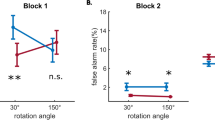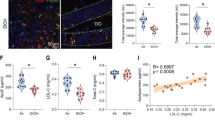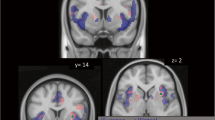Abstract
We present a substantial series of behavioral and imaging experiments, which demonstrate, for the first time, that increasing AMPA receptor-mediated neurotransmission via administration of potent and selective biarylsulfonamide AMPA potentiators LY404187 and LY451395 reverses the central effects of an acutely intoxicating dose of ethanol in the rat. Using pharmacological magnetic resonance imaging (phMRI), we observed that LY404187 attenuated ethanol-induced reductions in blood oxygenation level dependent (BOLD) in the anesthetized rat brain. A similar attenuation was apparent when measuring local cerebral glucose utilization (LCGU) via C14-2-deoxyglucose autoradiography in freely moving conscious rats. Both LY404187 and LY451395 significantly and dose-dependently reversed ethanol-induced deficits in both motor coordination and disruptions in an operant task where animals were trained to press a lever for food reward. Both prophylactic and acute intervention treatment with LY404187 reversed ethanol-induced deficits in motor coordination. Given that LY451395 and related AMPA receptor potentiators/ampakines are tolerated in both healthy volunteers and elderly patients, these data suggest that such compounds may form a potential management strategy for acute alcohol intoxication.
Similar content being viewed by others
Log in or create a free account to read this content
Gain free access to this article, as well as selected content from this journal and more on nature.com
or
References
Anton RF (1996). Neurobehavioural basis for the pharmacotherapy of alcoholism: current and future directions. Alcohol Alcohol 31: 43–53.
Arvola A, Sammalisto L, Wallgen H (1958). A test for level of alcohol intoxication in the rat. Q J Stud Alcohol 19: 563–572.
Barwick VS, Dar MS (1998). Adenosinergic modulation of ethanol-induced motor incoordination in the rat motor cortex. Prog Neuropsychopharmacol Biol Psychiatry 22: 587–607.
Bellinger FP, Davidson MS, Bedi KS, Wilce PA (2002). Neonatal ethanol exposure reduces AMPA but not NMDA receptor levels in the rat neocortex. Dev Brain Res 136: 77–84.
Bowen SE, Balster RL (1997). Desflurane, enflurane, isoflurane and ether produce ethanol-like discriminative stimulus effects in mice. Pharmacol Biochem Behav 57: 191–198.
Brett M, Anton J-L, Valabreque R, Poline J-P (2002). Region of interest analysis using an SPM toolbox. Abstract presented at the 8th international conference on functional mapping of the human brain, 2–6 June 2002, Sendai, Japan. Available on CD-ROM in NeuroImage, vol. 16, no 2.
Calhoun VD, Altschul D, McGinty V, Shih R, Scott D, Sears E et al (2004). Alcohol intoxication effects on visual perception: an fMRI study. Hum Brain Mapp 21: 15–26.
Carboni S, Isola R, Gessa GL, Rosetti ZL (1993). Ethanol prevents the glutamate release induced by N-methyl-D-aspartate in the rat striatum. Neurosci Lett 152: 133–136.
Charalambous MP (2002). Alcohol and the accident and emergency department: a current review. Alcohol Alcohol 37: 307–312.
Colombo G, Grant KA (1992). NMDA receptor complex antagonists have ethanol-like discriminative stimulus effects. Ann NY Acad Sci 654: 421–423.
Cowen MS, Schroff K-C, Gass P, Sprengel R, Spanagel R (2003). Neurobehavioral effects of alcohol in AMPA receptor subunit (GluR1) deficient mice. Neuropharmacology 45: 325–333.
Duncan GE (1992). High resolution autoradiographic imaging of brain activity patterns with 2-deoxyglucose: regional topographic and cellular analysis. In: Gonzalez-Lima F, Finkenstädt T, Scheich H (eds). Advances in Metabolic Mapping Techniques for Brain Imaging of Behavioural and Learning Functions. Kluwer Academic Publishers: Netherlands. pp 152–172.
Eckardt MJ, Campbell GA, Marietta CA, Majchrowicz E, Weight FF (1998). Acute ethanol administration selectively alters localized cerebral glucose metabolism. Brain Res 444: 53–58.
Frölich R, Patzelt C, Illes P (1994). Inhibition by ethanol of excitatory amino acid receptors and nicotinic acetylcholine receptors at rat locus coeruleus neurons. Naunyn-Schmiedeberg's Arch Pharmacol 350: 626–631.
Frye GD, Fincher A (2000). Sustained ethanol inhibition of native AMPA receptors on medial septum/diagonal band (MS/DB) neurons. Br J Pharmacol 129: 87–94.
Gates M, Ogden A, Bleakman D (2001). Pharmacological effects of AMPA receptor potentiators LY392098 and LY404187 on rat neuronal AMPA receptors in vitro. Neuropharmacology 40: 984–991.
Grant KA, Knisely JS, Tabakoff B, Barrett JE, Balster RL (1991). Ethanol-like discriminative stimulus effects of non-competitive n-methyl-d-aspartate antagonists. Behav Pharmacol 2: 87–95.
Gruol DL, Parsons KL, DiJulio N (1997). Acute ethanol alters calcium signals elicited by glutamate receptor agonists and K+ depolarization in cultured cerebellar Purkinje neurons. Brain Res 773: 82–89.
Harwood H (2000). Updating estimates of the economic costs of alcohol abuse in the United States: estimates, update methods, and data. Report prepared by The Lewin Group for the National Institute on Alcohol Abuse and Alcoholism. Based on estimates, analyses, and data reported in Harwood H; Fountain D; and Livermore G. The Economic Costs of Alcohol and Drug Abuse in the United States 1992. Report prepared for the National Institute on Drug Abuse and the National Institute on Alcohol Abuse and Alcoholism, National Institutes of Health, Department of Health and Human Services. NIH Publication No. 98–4327. National Institutes of Health: Rockville, MD, 1998.
Horowski R, Dorow R (2002). Anxiogenic, not psychotogenic, properties of the partial inverse benzodiazepine receptor agonist FG 7142 in man. Psychopharmacology 162: 223–224.
Jhee SS, Chappell AS, Zarotsky V, Moran SV, Rosenthal M, Kim E et al (2006). Multiple-dose plasma pharmacokinetic and safety study of LY450108 and LY451395 (AMPA receptor potentiators) and their concentration in cerebrospinal fluid in healthy human subjects. J Clin Pharmacol 46: 424–432.
Jones N, O'Neill MJ, Tricklebank M, Libri V, Williams SCR (2005). Examining the effects of the AMPA receptor potentiator LY404187 in the rat brain using pharmacological magnetic resonance imaging. Psychopharmacology 180: 743–751.
June HL, Lewis MJ (1994). Interactions of Ro15-4513, Ro15-1788 (flumazenil) and ethanol on measures of exploration and locomotion in rats. Psychopharmacology 116: 309–316.
Khanna JM, Kalant H, Chau A, Shah G (1998). Rapid tolerance and crosstolerance to motor impairment effects of benzodiazepines, barbiturates and ethanol. Pharmacol Biochem Behav 59: 511–519.
Krystal JH, Karper LP, Seibyl JP, Freeman GK, Delaney R, Bremner JD et al (1994). Subanaesthetic effects of the noncompetitive NMDA antagonist, ketamine, in humans. Psychotomimetic, perceptual, cognitive, and neuroendocrine responses. Arch Gen Psychiat 51: 199–214.
Krystal JH, Petrakis IL, Webb E, Cooney NL, Karper LP, Namanworth S et al (1998). Dose-related ethanol-like effects of the NMDA antagonist, ketamine, in recently detoxified alcoholics. Arch Gen Psychiat 55: 354–360.
Kulkarni SK, Mehta AK, Ticku MK (1990). Comparison of anticonvulsant effects of ethanol against NMDA-, kainic acid- and picrotoxin-induced convulsions in rats. Life Sci 46: 481–487.
Levin JM, Ross MH, Mendleson JH, Kaufman MJ, Lange N, Maas LC et al (1998). Reduction in BOLD fMRI response to primary visual stimulation following alcohol ingestion. Psychiatry Res 82: 135–146.
Li X, Tizzano JP, Griffey K, Clay M, Lindstrom T, Skolnick P (2001). Antidepressant-like actions of an AMPA receptor potentiator (LY392098). Neuropharmacology 40: 1028–1033.
Liguori A, D'Agostino Jr RB, Dworkin SI, Edwards D, Robinson JH (1999). Alcohol effects on mood, equilibrium, and stimulated driving. Alcohol Clin Exp Res 23: 815–821.
Lovinger DM, White G, Weight FF (1990). NMDA receptor-mediated synaptic excitation selectively inhibited by ethanol in hippocampal slice from adult rat. J Neurosci 10: 1372–1379.
Lyons D, Miller MD, Hedgecock-Rowe AA, Crane AM, Porrino LJ (1998). Time-dependent effects of acute ethanol administration on regional cerebral blood flow in the rat. Alcohol 16: 213–219.
Martin D, Tayyeb MI, Swartzwelder S (1995). Ethanol inhibition of AMPA and kainite receptor-mediated depolarizations on hippocampal area CA1. Alcohol Clin Exp Res 19: 1312–1316.
Meng ZH, Dar MS (1994). Intrastriatal Ro15-4513 functionally antagonizes ethanol-induced motor incoordination and striatal adenosinergic modulation of ethanol-induced motor incoordination in rats. J Pharmacol Exp Ther 271: 524–534.
Möykkynen T, Korpi ER, Lovinger DM (2003). Ethanol inhibits α-amino-3-hydroxy-5-methyl-4-isoxazolepropionic acid (AMPA) receptor function in central nervous system neurons by stabilizing desensitization. J Pharmacol Exp Ther 306: 546–555.
Newlin DB, Golden CJ, Quaife M, Graber B (1982). Effect of alcohol ingestion on regional cerebral blood flow. Int J Neurosci 17: 145–150.
O'Neill MJ, Bleakman D, Zimmerman DM, Nisenbaum ES (2004). AMPA receptor potentiators for the treatment of CND disorders. Curr Drug Targets CNS Neurol Disord 3: 181–194.
Ogawa S, Tank DW, Menon R, Ellermann JM, Kim SG, Merkle H et al (1992). Intrinsic signal changes accompanying sensory stimulation: functional brain mapping with magnetic resonance imaging. Proc Natl Acad Sci USA 89: 5951–5955.
Paxinos G, Watson C (1986). The rat brain in stereotaxic co-ordinates. Academic press: UK.
Prediger RD, Takahashi RN (2005). Ethanol improves short-term social memory in rats—involvement of opiod and muscarinic receptors. Eur J Pharmacol 462: 115–123.
Quirk JC, Nisenbaum ES (2002). LY404187: a novel positive allosteric modulator of AMPA receptors. CNS Drug Rev 8: 255–282.
Sanchis-Segura C, Borchardt T, Vengeliene V, Zghoul T, Bachteler D, Gass P et al (2006). Involvement of the AMPA receptor GluR-C subunit in alcohol-seeking behavior and relapse. J Neurosci 26: 1231–1238.
Schecter MD, Meehan SM, Gordon TL, McBurney DM (1993). The NMDA receptor antagonist MK-801 produces ethanol-like discrimination in the rat. Alcohol 10: 197–201.
Shpilenya LS, Muzychenko AP, Gasbarrini G, Addolorato G (2002). Metadoxine in acute alcohol intoxication: a double-blind, randomized, placebo-controlled study. Alcohol Clin Exp Res 26: 340–346.
Suzdak PD, Paul SM, Crawley JN (1988). Effects of Ro15-4513 and other benzodiazepine receptor inverse agonists on alcohol-induced intoxication in the rat. J Pharmacol Exp Ther 245: 880–886.
Tiihonen J, Kuikka J, Hakola P, Paanila J, Airaksinen J, Eranen M et al (1994). Acute ethanol-induced changes in cerebral blood flow. Am J Psychiatry 151: 1505–1508.
Trussell LO, Fischbach GD (1989). Glutamate receptor desensitization and its role in synaptic transmission. Neuron 3: 209–218.
Tsai G, Gastfriend DR, Coyle JT (1995). The glutamatergic basis of human alcoholism. Am J Psychiatry 152: 332–340.
Wang GJ, Volkow ND, Franceschi D, Fowler JS, Thanos PK, Scherbaum N et al (2000). Regional brain metabolism during alcohol intoxication. Alcohol Clin Exp Res 24: 822–829.
Wang M-Y, Rampil IJ, Kendig JJ (1999). Ethanol directly depresses AMPA and NMDA currents in spinal cord motor neurons independent of actions on GABAA or glycine receptors. J Pharmacol Exp Ther 290: 362–367.
White AM, Roberts DC, Best PJ (2002). Contest-specific tolerance to the ataxic effects of alcohol. Pharmacol Biochem Behav 72: 107–110.
Williams-Hemby L, Porrino LJ (1994). Low and moderate doses of ethanol produce distinct patterns of cerebral metabolic changes in rats. Alcohol Clin Exp Res 18: 982–988.
Wirkner K, Eberts C, Poelchen W, Allgaier C, Illes P (2000). Mechanism of inhibition by ethanol of NMDA and AMPA receptor channel functions in cultured rat neurons. Naunyn-Schmiedeberg's Arch Pharmacol 362: 568–576.
Acknowledgements
This research was funded by Eli Lilly and Co. Ltd. The MRI spectrometer was provided by the University of London Intercollegiate Research Service scheme and is located at Queen Mary and Westfield College London managed by Dr Alasdair Preston.
Author information
Authors and Affiliations
Corresponding author
Additional information
DISCLOSURE/CONFLICT OF INTEREST
This research was funded by Eli Lilly and Co Ltd. Marcus Messenger, Michael O'Neill, Gary Gilmour, Rosa Simmons, Smirti Iyengar, and Mark Tricklebank are employed by Eli Lilly and Co Ltd. Vincenzo Libri was employed by Eli Lilly and Co Ltd when the experiments were conducted.
Rights and permissions
About this article
Cite this article
Jones, N., Messenger, M., O'Neill, M. et al. AMPA Receptor Potentiation can Prevent Ethanol-Induced Intoxication. Neuropsychopharmacol 33, 1713–1723 (2008). https://doi.org/10.1038/sj.npp.1301562
Received:
Revised:
Accepted:
Published:
Issue date:
DOI: https://doi.org/10.1038/sj.npp.1301562
Keywords
This article is cited by
-
Glutamatergic targets for new alcohol medications
Psychopharmacology (2013)
-
New medications for drug addiction hiding in glutamatergic neuroplasticity
Molecular Psychiatry (2011)



